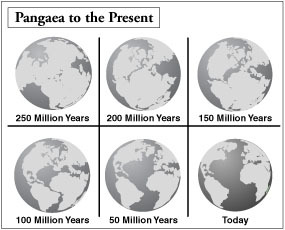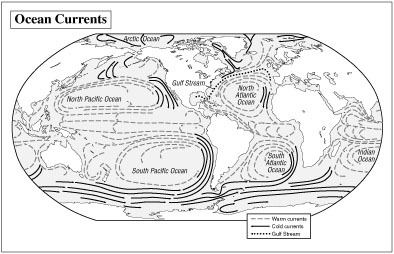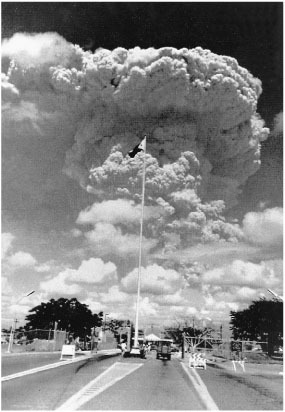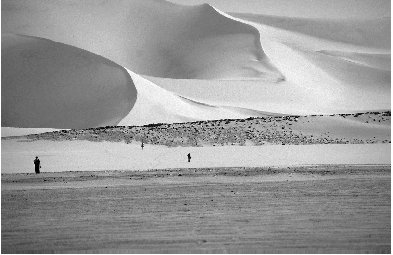Chapter 1
What Is Global Warming?

The mystery of how the earth remains warm enough to sustain life is one that puzzled scientists for hundreds of years. Then during the nineteenth century, a French scientist developed a theory about how the planet was heated, and the mystery was solved. Jean-Baptiste-Joseph Fourier was curious about the sun—specifically, how it was possible that the sun's rays hit the oceans and land and did not just bounce back into space. Fourier knew the earth must somehow have the ability to retain the sun's heat. The very existence of living things was proof of that. So he concluded that only some of the sun's rays escaped back into space, while some were trapped and held by the earth's atmosphere. He compared this function to a giant glass vessel, which let in the sun's light and then trapped and retained its warmth inside.
Fourier wrote about his theory in a paper, published in France in 1824, entitled "General Remarks on the Temperature of the Terrestrial Globe and Planetary Spaces." Six years later he died, and all but a few scientists forgot about his ideas. At that time, no one could have known how important Fourier's theory would become in the future, or that later it would assume the name greenhouse effect.
The Earth's Natural Thermostat
What Fourier had discovered was the key to the earth's ability to naturally regulate its own temperature. This is possible because of a natural balance between the sun, the land and oceans, and the atmosphere—a balance that is critical to the survival of all living things.
Earth absorbs only a certain amount of the sun's energy. If it absorbed too much sunlight, the planet would become as hot as the sun and eventually burn up. Actually, about 30 to 40 percent of the sun's heat is absorbed by the land, air, and oceans, while the rest is radiated outward, toward space. As Fourier suspected, though, not all of the sun's energy ends up back in space. Some of it remains in the atmosphere, which is made up of four separate layers: the troposphere (closest to Earth), the stratosphere, the mesosphere, and the thermosphere. Surrounding the earth like a protective blanket, the atmosphere is made up of invisible gases such as nitrogen, oxygen, argon, water vapor, ozone, helium, methane, and carbon dioxide, among others. Gases such as water vapor, CO 2 , methane, and nitrous oxide are composed of molecules that have the ability to trap and hold heat. So, as the sun's energy is reflected away from Earth, these heat-trapping gases capture that energy and then reradiate it toward the surface.
This process is called the greenhouse effect because it is so similar to the way a greenhouse works—its glass panes allow the sunlight in, while trapping the heat inside. Thus, the greenhouse effect is essential because without it the earth would become extremely cold, and it is doubtful that any living thing could survive. The average surface temperature of the planet is now 59 degrees Fahrenheit. If the atmosphere did not trap and hold heat, the average temperature would be a frigid -0.4 degrees.
Climate vs. Weather
Another term for the earth's average temperature is global climate. Of course, there are vast differences in climate throughout the world based on the amount of sunlight that different regions receive. For instance, some countries, such as Egypt, Ethiopia, and Iraq, receive intense sunlight all year long, so their climates are much hotter than climates of countries farther away from the equator. The South Pole is the opposite. It is located on the continent of Antarctica, at the southernmost point on the earth, and temperatures are colder there than anywhere else in the world.
When referring to climate some people actually mean weather, and while the two are closely related, they are not the same thing. Weather is more temporary, fluctuating from month to month, day to day, or even hour to hour. Climate, on the other hand, remains constant. It refers to the average weather and temperatures that are normal for a particular region during a month, a season, or a decade. When a permanent weather change occurs, only then is it a statement about climate. Dr. Richard C.J. Somerville, a professor of meteorology at Scripps Institute of Oceanography in California, explains this:
In a nutshell, the difference between weather and climate is that weather deals with the instantaneous state of the atmosphere. If I say there will be a thunderstorm in London on Thursday afternoon, that's a statement about the weather. But climate deals with longer time scales and with averages and other statistics over space and time. So that if I say London next summer will be drier and warmer than usual, that's a statement about climate. A catchy way to put it is that climate is what you expect, and weather is what you get. 3
How Climate Has Varied
For as long as the earth has existed, it has experienced changes in climate, including many different periods of warming and cooling. One example of a particularly cold era was the Pleistocene epoch, more commonly called the Ice Age. During the Ice Age, which lasted for thousands of years, approximately 30 percent of the planet's surface was covered with thick ice sheets and enormous rivers of ice known as glaciers. The cold period came to an end around 13,000 B . C ., and the earth gradually began to grow warmer.
In the mid-1500s, after centuries of warmth, the earth experienced another extremely cold period called the Little Ice Age. Scientists have discovered records that were kept by people living in Iceland during that time, and those writings have helped researchers understand the effects of the cold temperatures and frozen conditions. For instance, the Icelanders made their living by fishing and they recorded that between 1650 and 1850, their island was completely icebound for several months each year. This caused hardship for them because it hindered their ability to fish. When the temperature began to warm up in 1880, they wrote about their relief that the ice had finally begun to recede, so they could extend their fishing season.
Since the Little Ice Age ended toward the end of the 1800s, the earth has steadily grown warmer. Scientists call this trend global warming, and the National Oceanic and Atmospheric Administration (NOAA) defines it as follows: "The term Global Warming refers to the observation that the atmosphere near the Earth's surface is warming, without any implications for the cause or magnitude. This warming is one of many kinds of climate change that the Earth has gone through in the past and will continue to go through in the future." 4 Because the planet has experienced such periods of warming and cooling throughout its history, some scientists believe that the current warming is just one more product of nature—that the earth is simply doing what it has always done in the past.
Continental Drift
Since the earth has existed, many natural phenomena have affected its changes in climate. One example is continental drift, which is a theory accepted by most scientists and historians. It is based on the belief that 200 million years ago the earth was one large landmass, or supercontinent, called Pangaea. Over millions of years, Pangaea split into separate chunks of land, forming the continents that currently exist. Scientists studying the continents discovered that their coastlines are shaped as though they once fit together, similar to the pieces of a jigsaw

The formation of separate continents caused some areas of the earth to move to new locations over millions of years. Scientists believe this resulted in extreme climatic changes. Whereas Antarctica is now a frozen continent, studies of plant fossils confirm that it was once a tropical place, near the equator, where lush, swampy vegetation thrived. At the other extreme, evidence of glaciers has been found in the southern part of the African continent. This is likely to mean that Africa, now one of the world's hottest regions, was once very cold—possibly even as cold as the South Pole is today.
Although the most dramatic phase of continental drift happened millions of years ago, the continents are still on the move. This is explained by plate tectonics, which theorizes that the earth's crust is divided into twelve gigantic chunks (or plates) that are constantly shifting. Beneath them is the earth's constantly churning core of molten rock, known as the mantle. The plates float on top of the mantle, continuously sliding around, crunching against each other, and pulling apart. In the same way that continental drift changed the planet in the past, the constant moving and shifting of plate tectonics continues to shape the oceans and land. As a result, mountains form and oceans shift direction, and there are also changes in air circulation, or the ongoing motion of the atmosphere over the earth. As these changes occur, climate is affected.
Ocean Activity
The earth's oceans play a major role in regulating climate, and strongly influence climate changes. These huge bodies of water cover about 70 percent of the planet's surface, and they have a tremendous capacity to hold and store heat from the sun. Most heat that escapes from oceans is in the form of water vapor, which is the most plentiful atmospheric gas. When ocean waters become warmer than usual, such as when they absorb higher-than-average levels of sunlight, they emit more water vapor into the atmosphere. This affects the earth's climate in two ways: Because water vapor is a powerful heat-trapping gas, more water vapor means that more heat is retained in the atmosphere; and water vapor contributes to the formation of clouds, which shade the earth and have an overall cooling effect.
Ocean currents also exert a strong influence on the earth's climate. Like great rivers, these masses of water are constantly on the move—twisting, turning, and winding their way through the oceans. As they move along regular paths, currents carry the oceans' stored heat across the planet. One example of a major ocean current is the Gulf Stream, which carries warm water from the Caribbean Sea up the east coast of the United States, and across the North Atlantic to the west coasts of Great Britain and northern Europe. Because of the Gulf Stream, these areas are much warmer than they would be if it did not exist. Other ocean currents function in much the same way.
When currents slow down or change direction, the earth's climate is affected. Dr. Robert B. Gagosian, president of the Woods Hole Oceanographic Institution, explains how the oceans influence worldwide climates:
The ocean isn't a stagnant bathtub. It circulates heat around the planet like the heating and cooling system in your house. The atmosphere and oceans are equal partners in creating Earth's climate. The atmosphere is a rabbit. It moves fast. Rapid changes in atmospheric circulation
cause storms, cold spells, or heat waves that play out over several days. The ocean, on the other hand, is a turtle. It may take years or decades or even millennia for similar "disturbances" to circulate through the ocean. But the ocean is a big turtle. It stores about 1,000 times more heat than the atmosphere. So changes in ocean circulation can set the stage for large-scale long-term climate changes. 5
Volcanoes
Among the powerful natural forces that can influence the earth's climate are volcanoes. When volcanoes erupt, they send huge clouds of volcanic material—including sulfur dioxide, water vapor, dust, and ash—many miles into the atmosphere. The volcanic material forms a thick haze that prevents sunlight from reaching Earth and can cause global cooling. This is especially true during the most violent eruptions, such as one that occurred over seventy thousand years ago on the island of Sumatra. A volcano known as Toba erupted with such immense force that it released more than six hundred cubic miles of sulfur and ash into the sky. According to geologist William Hutton, the eruption, which buried most of India under ash, caused significant changes in the global climate. He describes the effects of Toba: "This was a true cataclysm . . . because it had significant worldwide effects. An estimated 75 percent of the Northern Hemisphere's plants may have died. At the end of the first six years of climate cooling, a thousand-year ice age began. Perhaps only a few thousand people, living

A more recent example of volcanic activity occurred at Mount Pinatubo, which erupted in the Philippines in 1991. The eruption was Mount Pinatubo's first in over four hundred years, and it was considered the most violent volcanic event of the twentieth century. During a series of eruptions that lasted for seven days, clouds of volcanic material were blasted twelve miles high, and remnants of the sulfur and ash reached as far away as Russia and North America. Afterward, scientists estimated that the eruption had caused a decrease in global temperatures of about one degree Fahrenheit that lasted for about two years.
The Earth's Orbit and Tilt
The tilt of the planet is another natural phenomenon that can affect climate. As Earth travels around the sun, a process that takes 365 days, it is not pointing straight up and down. Instead, it is tilted at a 23.45-degree angle. The greater the tilt, the more sunshine the North Pole and South Pole receive during the summer. So, if the earth's tilt were to change, the climate would change as well. For example, with the earth's current tilt, it remains cold enough at the poles to keep much of their surfaces permanently covered with ice. If the planet's tilt were to increase, the poles would receive more sun in the summer, and the ice cover would likely begin to shrink. If, however, the earth's tilt were to decrease, the poles would be colder and the ice sheets and glaciers would probably expand.
Earth is not perfectly still during its orbital process. It actually wobbles in space, and that can cause the degree of the tilt to change. This wobbling also causes variations in the planet's distance from the sun, which affects the amount of solar energy that reaches the surface. One profound example of how changes in Earth's orbit and tilt affect climate is the Sahara Desert in northern Africa. By using a computer simulation of the earth's climate, German researchers discovered that until about four thousand years ago, the Sahara was a fertile area where agriculture thrived and people could farm the land. Over a period of hundreds of years, Earth's tilt changed, causing the African continent to tilt closer to the sun. As a result, temperature rose dramatically and the vast desert that exists today was created. Scientists speculate that when the agricultural land evolved into desert, it may have forced early civilizations to leave the area and settle along the valleys of the Nile, the Tigris, and the Euphrates Rivers.
Clouds
Areas like the Sahara Desert have the hottest climates on the earth because they are close to the equator, and also because they have very little cloud cover. Clouds are formed when water vapor in the air rises into the sky, and then cools down and condenses. This happens most often in areas where there is an abundance of water. Because deserts have virtually no water, there is almost no moisture in the air. So, clouds rarely form in these areas and there is almost no precipitation. In other regions of the world where more clouds hover overhead, regular rainfall and snow are common and temperatures are cooler.
Clouds are a powerful influence on global climate because they block much of the sun's energy, reflecting it back into space before it can be absorbed by Earth or the atmosphere. So, the thicker and more plentiful clouds are, the cooler the earth will be. If there were no clouds in the sky, the planet would be about twenty degrees hotter than it is today.
Continued Study
Scientists are in agreement that climate can be influenced by natural causes. Regardless of where they stand on the global warming issue, all believe that it

Dr. Wallace S. Broecker, a geology professor at Columbia University in New York City, and a well-known scientific researcher, offers his perspective on the importance of climate research:
As I sometimes tell my students, the folks in the back room who designed our planet were pretty clever. We have clear evidence that different parts of the earth's climate system are linked in very subtle yet dramatic ways. The climate system has jumped from one mode of operation to another in the past. We are trying to understand how the earth's climate system is engineered, so we can understand what it takes to trigger mode switches. Until we do, we cannot make good predictions about future climate change. 7
A silverfox that would come out in day light like the rest and walk the drive way. Any new informaion would be greatly appreciated. We used to have gators here. Not in the past year or so.